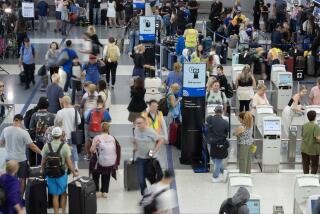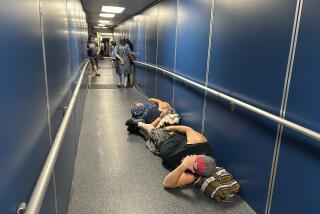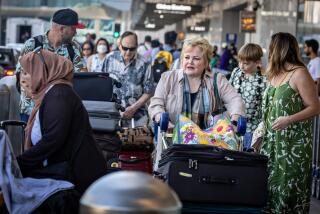Tragedy Rekindles Debate Over How Much Security Is Enough
WASHINGTON — The fiery crash of TWA Flight 800 has ignited new concern over the adequacy of security precautions and screening procedures used by airlines and airports in the United States and around the world.
Although authorities cautioned that they have no evidence of sabotage or an attack in this case, the huge fireball--and the absence of any immediate signs that the aircraft was in trouble until it exploded off the New York coast--has led to speculation about terrorist involvement. Members of Congress on Thursday called in Federal Aviation Administration officials for briefings on the status of screening procedures.
In preparation for the Olympic Games in Atlanta, the FAA had already ordered airport security increased to a level 3, its second-highest category. Since the TWA tragedy there have been reports that the agency is considering boosting that to level 4.
It is not clear, however, just how secure commercial aviation is from terrorist attacks. A 1993 report by Transportation Department Inspector General Mary F. Schiavo branded the FAA’s oversight as inadequate and said it could not rely on security systems.
Schiavo said Thursday that she updated that assessment just before she resigned earlier this month but that the department has refused to make her update public on grounds that doing so would only aid would-be terrorists. Even members of Congress have been kept in the dark.
Airline security unquestionably is far better than it was even a decade ago. At U.S. insistence, the worldwide procedures that permitted the bombing of Pan Am Flight 103 over Lockerbie, Scotland, in 1988 have been tightened substantially.
For example, on all international flights bound to or from the United States, the FAA requires airlines to X-ray every piece of baggage and “match” each by computer to a passenger on the plane. Unaccompanied bags are sometimes destroyed.
The agency’s regulations also prohibit curbside check-in service on international flights. Screening with metal detectors is far more rigorous than it was. And many airlines compare data on passengers to “profiles” of the most frequently encountered would-be bombers.
Moreover, intensified pressure from the United States has succeeded in prodding other countries--such as Greece--to tighten security at their airports, making the global airline system far safer than it used to be.
“Airport security these days generally is excellent,” insisted Kenneth Quinn, who was chief counsel for the FAA when the Lockerbie crash occurred and is now a private consultant. The Pan Am episode “changed the whole world of airport security,” he said.
But security experts said the system is still far from foolproof.
For one thing, the technology is still relatively primitive. The only screening device capable of detecting explosives reliably is the CTX-5000, a kind of airport CAT scan. Each machine costs approximately $1 million, and the devices often emit “false positive” readings.
And while training for security personnel has improved substantially from a few years ago, analysts said there always is the possibility that a breakdown will occur--because of a mistake or possibly a bribe by a terrorist.
Many analysts were particularly concerned Thursday that the plane used for Trans World Airlines Flight 800 had just come in from Greece, where security has been erratic. The Transportation Department began warning U.S. passengers away from Athens in March, although it rescinded that policy in May.
At the same time, critics pointed out that U.S. airlines have yet to apply the same stringent standards to domestic flights that they do for international trips--such as X-raying and matching all baggage and eliminating curbside check-in service. Unattended bags abound.
Industry officials conceded that the standards vary widely between domestic and international flights, but they contend there are trade-offs that airlines must consider in terms of cost of operation and inconvenience for passengers.
To X-ray all bags on domestic flights would increase operating costs substantially and force passengers to spend still more time at airports awaiting flights, one consultant here pointed out. “I’m not sure how many people would be willing to put up with it,” he said.
A General Accounting Office report cites estimates by the FAA that the cost of purchasing and installing explosives detectors in the 75 busiest domestic airports could range from $400 million to $2.2 billion, depending on the systems involved.
Rep. James L. Oberstar (D-Minn.), ranking minority member of the House Transportation Committee, agreed that the trade-off question is a serious one.
“A great deal of progress has been made against ‘standard’ devices, such as guns, knives and other objects used to conduct skyjacking in the past,” he said, but bombs represent “a new level of threat to be met.”
“The security question that we must face is how much is the public willing to pay for security and how much inconvenience is the public willing to put up with to obtain that level of security?” he said.
“We could achieve 98% detection of all types of devices on carry-on and check-in luggage if we’re willing to treat domestic travel like the Israelis do--on a wartime footing,” he said. But he is not sure that Americans are ready for that.
Israel Boim, head of Air Security International in Houston, said the real question for authorities is what intelligence agencies say about the extent of the threat from terrorists at any given time.
“If the risk assessment is low, then I’d say the current system is adequate,” Boim said. If authorities have reason to believe that the threat is more widespread, then authorities have more work to do, he said.
Boim also disputed contentions that the public will not stand for the inconvenience of more stringent security procedures. Except for occasional vacationers, most air travelers have no choice, he said. “You can’t give up flying. There aren’t any alternatives.”
Times staff writers David Willman and Janet Hook contributed to this story.
(BEGIN TEXT OF INFOBOX / INFOGRAPHIC)
An Airport on Alert
The Federal Aviation Administration and airport officials constantly struggle with how much security is enough, weighing such factors as cost and time. Among the measures used at international airports in the United States:
SECURITY MEASURES
1) Vehicles: Unattended cars at curbs towed immediately
2) Barriers: Concrete planters and other barriers used to deter truck bombers
3) ID: Photo identification required at check in
4) Bags: “Passenger-bag matching” system matches bags placed aboard planes to a passenger (under the theory that most bombers do not want to be on a flight with their bomb).
5) X-ray: Carry-on bags and luggage X-rayed; suspicious bags hand-checked
6) Surveillance: Surveillance systems keep unauthorized persons from approaching aircraft
* Suspicious gifts: Passengers alerted against accepting gifts from strangers or leaving bags unattended
****
SECURITY LEVELS
There are four levels of security at U.S. airports, a system developed after the Gulf War. On Thursday, Los Angles International Airport was at Level 3:
1. Baseline, lowest level of security
2. Moderate security measures, stepped up patrols
3. Heightened surveillance, police patrols; cars left unattended at curbs will be towed
4. Highest level; curbside check-in is disallowed; gate access limited to passengers and security clearance personnel
****
WHAT TO EXPECT
Travelers should be prepared for possible delays as security measures are tightened in the wake of the New York crash. People who seem them off may not be allowed into gate areas. Airline officials are encouraged travelers to arrange backup meeting places.
Sources: Times staff and wire reports
More to Read
Sign up for Essential California
The most important California stories and recommendations in your inbox every morning.
You may occasionally receive promotional content from the Los Angeles Times.










